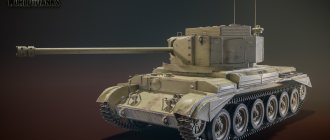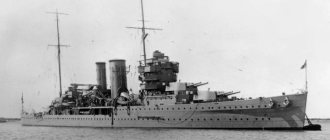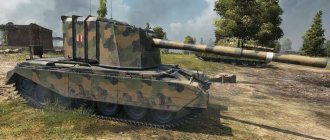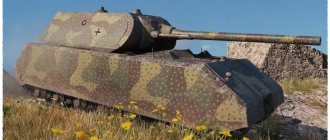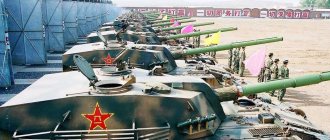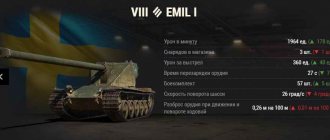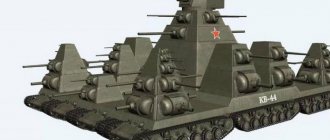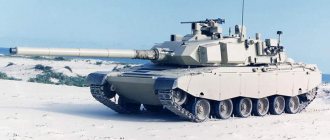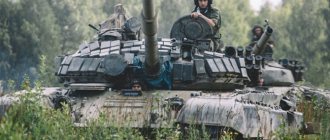Panzer Division (tank division) - a combined army formation of the Wehrmacht, which included tank units and motorized infantry, as well as artillery and other auxiliary units. The composition of the divisions, as well as the share of tank and motorized units in the divisions, changed. Wehrmacht tanks became the basis of blitzkrieg tactics.
| Tank Pz.Kpfw I | Tank Pz.Kpfw II | ||
| Tank Pz.Kpfw II "Lux" | |||
| Medium tanks | |||
| Tank Pz.Kpfw III | Tank Pz.Kpfw IV | ||
| Panther tank | |||
| Heavy tanks | |||
| Tank "Tiger" | Tank "Royal Tiger" | ||
| Super heavy tank "Mouse" | |||
| Self-propelled anti-tank guns | |||
| "Panzerjager" I | "Marder" II | ||
| "Nashorn" | "Marder" III | ||
| "Marder" I | "Marder 38" | ||
| Tank destroyers | |||
| "Hetzer" | "Jagdpatser" IV | ||
| "Jagdpanther" | "Ferdinand" | ||
| "Jagdtiger" | "Sturer Emil" | ||
| Self-propelled units | |||
| "Vespe" | "Hummel" | ||
| Anti-aircraft self-propelled gun "38" | "Wirbelwind" | ||
| 600-mm self-propelled mortar "Karl" | |||
| Assault guns | |||
| StuG III | "Brummber" | ||
| "Sturmtiger" | |||
| Wehrmacht armored vehicles | |||
| Armored car 222 | Armored car 231 | ||
| Armored personnel carrier 250 | Armored personnel carrier 251 | ||
The Wehrmacht tank division had its own motorized infantry, and since 1943, self-propelled artillery, which allowed the tanks to conduct independent operations (in the armies of the world, tanks were used to support other types of troops). The transfer of the leading role to tanks ensured the decisive success of the Wehrmacht in the initial period of the Second World War. Panzer divisions were divided into two categories: the standard Wehrmacht panzer division and the SS panzer divisions.
The concept of “Wehrmacht” acquired its meaning during the rise to power of the National Socialist German Workers' Party. The law on the creation of the armed forces was adopted on March 16, 1935, that is, two years after Hitler came to power. The "armed forces" consist of the ground forces (German: Heer), the navy (Kriegsmarine) and the air force (Luftwaffe). At their head, the corresponding governing bodies are created - the Supreme Commands.
High Command of the Wehrmacht
On February 7, 1938, the Wehrmacht High Command (OKW) was created from the Armed Forces Directorate of the War Ministry, subordinate directly to the Supreme Commander-in-Chief, Adolf Hitler, and called the Fuhrer's Headquarters. There is no post of Minister of War. The OKW had four directorates:
- Operations Department - A. Jodl;
- military intelligence and counterintelligence - Abwehr - V. Canaris;
- economic department (supply and armament of the army) - G. Thomas
- general purpose control. General (from 1940 - Field Marshal) Wilhelm Keitel was appointed chief of staff of the Supreme High Command of the Armed Forces.
Wehrmacht organization
- High Command of the German Armed Forces - OKW;
The branches of the military are headed by the corresponding high commands:
- Supreme Command of the Ground Forces - OKH;
- Supreme Command of the Navy - OKM;
- High Command of the Air Force (Luftwaffe) - OKL.
The Supreme Commander of the Wehrmacht was Reich Chancellor Adolf Hitler. The Supreme Command is headed by the commander-in-chief of the corresponding branch of the armed forces. Each branch of the army had its own commander-in-chief, chief of staff and staff, who were subordinate to the chief of staff of the operational leadership of the Wehrmacht, and he, in turn, to the chief of staff of the headquarters, headed by Hitler as the supreme commander-in-chief.
Organizational structure of the Wehrmacht High Command (OKW)
- Supreme Commander: Fuhrer and Chancellor
- Commander of the Ground Forces
- Commander of the Navy
- Commander of the Air Force
1938 - 1941
- Supreme Commander and Minister of War: Fuhrer and Chancellor
- Commander-in-Chief of the Armed Forces
- Commander of the Ground Forces
- Commander of the Navy
- Commander of the Air Force
1941 - 1945
- Supreme Commander, Minister of War and Commander-in-Chief of the Army: Führer and Chancellor
- Chief of Staff of the Ground Forces
- Commander-in-Chief of the Armed Forces
- Commander of the Navy
- Commander of the Air Force
Panhard EBR 105
A lot depends on fireflies in battle, so it would be strange to bypass these small and fast tanks. This type of technique, as you know, requires a certain skill and knowledge. The main thing on a light tank is not damage, but to provide light to your allies. However, top fireflies are capable of not only shining, but also from time to time “biting” enemies distracted by other tanks.
The level 10 French wheeler is an ideal tank for both dealing damage and active coverage. Yes, it requires a certain amount of endurance and a head on your shoulders. He does not forgive thoughtless play and hasty bursts. But if you learn to play it, you will get extraordinary fun.
This is the fastest tank in the game with excellent stabilization, fast aiming, perfect camouflage, good gun depression angles and one-time damage of 390. At the same time, it pays with weak penetration, long reload time and poor visibility. If you feel that you will not be able to react quickly to what is happening in battle or your computer does not support consistently high FPS, then EBR 105 is not for you. In this case, it is worth taking a closer look at the T-100 LT or AMX 13 105.
Wehrmacht strength
- By the beginning of World War II, 12 army corps of 38 divisions were formed, with a total strength of 582,000 people. The total strength of the Wehrmacht was 4.6 million people (the total strength of the Wehrmacht is also given - 3,214,000 people).
- At the beginning of the Great Patriotic War, the total strength of the Wehrmacht was 7,234,000 people. The Ground Forces had 103 divisions, including 43 infantry divisions, including 21 that were not fully equipped on the western border. In the east there were 55 large military formations and several smaller ones.
- In 1943, the strength of the Wehrmacht reached 11,000,000 people.
- Beginning in the winter of 1941, the size of the army began to decline due to the fact that reinforcements did not compensate for the losses. For example, in June 1941 there were 3 million people on the Eastern Front, but at the end of the Second World War only 1.5 million remained here.
- In total, 21,107,000 people were drafted into the German armed forces between 1939 and 1945.
| The last military formations of the Wehrmacht were disarmed by September 1945. The Wehrmacht was dissolved by Allied Control Council Law No. 34 of August 20, 1946. |
Tanks and their generations
Usually in the literature devoted to the history and development of armored vehicles, the concept of “tank generation” is usually understood as a group of such combat vehicles that are characterized by approximately the same technical parameters and design solutions, regardless of the time the tanks were put into service. Despite the variety of designs and types of tanks developed before the Second World War, a generation is not visible among them.
The first generation dates back to 1950-1960.
The tanks that were being developed or already in service during this period were generally very similar (from a technical point of view) to the best tracked fighting vehicles of the Second World War, such as the T-34-85 or the Panther.
Designers from all tank-building countries adopted the achievements of Soviet tank builders and metallurgists in the production of cast turrets, and American ones in the production of fire control systems (a new optical rangefinder on the M47 tank), transmissions (hydrokinetic transmission) and chassis elements (rubber-metal tracks). Tank crews were reduced everywhere from five to four.
The first generation tanks include the American M47, M48A1 and M48A2 tanks, the British Centurions, the Soviet T-54 and T-55, and the Japanese Type 61 (this tank entered service in 1961, but was designed in the 50s). As for the Centurions and T-55, we are talking about the main models, which over time have undergone deep modernizations.
The second generation of tanks dates back to 1960-1970.
It was typical for tanks of those years:
• widespread use of main weapon stabilization systems;
• widespread use of active combat systems in conditions of limited visibility (night vision devices);
• use of mechanical ballistic computers;
• the beginning of the use of systems for protection against weapons of mass destruction;
• an increase in the caliber of the guns used (the T-62 had a 115-mm gun; the English 105-mm L7 rifled gun became widespread).
The second generation tanks include the American M60, M60A1, the English Chieftain, Vickers Mk 1 (Vijayanta), the Soviet T-62, the French AMX-30, the German Leopard (modifications A1, A2 and A3), the Swiss Pz61, Swedish Strv-103.
The next decade (1970-1980) is considered by experts as transitional. The best tanks of those years were, as a rule, modernized examples of previously built vehicles. More complex fire control systems were installed on them (analog computers, laser rangefinders, etc.), and stabilization systems for surveillance devices were tested. Passive surveillance systems have appeared for conducting combat operations in conditions of limited visibility. Work on new types of booking has come a long way. During this period, new designs also appeared, the level of which, in general, did not differ from the then prevailing standards, although the solution of some components and assemblies was very original and innovative. An example of this is the Japanese Type 74 tank with adjustable hydropneumatic suspension and the American M60A2 with a 152-mm ATGM gun-launcher.
The main representatives of this first transitional generation are the American M60A2 and M60AZ tanks, the English Vickers Mk 3, the German Leopard-1A4, the Soviet T-64 and T-72, the Italian OF-40, the Swiss Pz68, the Japanese Type 74 and the Israeli " Merkava Mk1.
Tanks that appeared before the beginning of the 90s belong to the third generation of tanks, which currently form the core of the ground forces of the armies of highly developed countries.
Their distinctive features are:
• the presence of an integrated fire control system, which includes a digital ballistic computer, a laser rangefinder, a set of sensors for external and internal conditions, a thermal imaging system for monitoring and targeting a target, allowing effective fire at any time of the day or night;
• the use of even larger caliber guns (Soviet tanks began to be equipped with 125 mm smoothbore guns even earlier, other countries switched mainly to 120 mm smoothbore guns);
• use of hydrostatic transmission in control systems, providing rotation with any radius;
• the possibility of using alternative power plants (gas turbine engines on the M1 Abrams and T-80);
• reduction in crew size to three people (T-80 and Type 90);
• widespread use of hydropneumatic suspension (Challenger, Type90, Type 88);
• refusal of further attempts to use ATGM launchers as the main weapon.
Third generation tanks include the American M1 Abrams and its modification A1, the English Challenger 1, the Soviet T-80 in several modifications, the German Leopard 2, the Israeli Merkava Mk 3 and the Italian S1 Ariete. The last two tanks were developed much later, but the decisive factor is not the date of manufacture, but the level of design.
The presence of a significant number of second-generation tanks and the high cost of third-generation tanks prompted the idea of carrying out a deep modernization of the first to the level of the most modern vehicles. As a result of the work carried out, tanks of the so-called second transitional generation appeared: the American “Super” M60, the British “Chieftain 800” and “Chieftain 900”, the French AMX-32 and AMX-40. True, none of them left the prototype stage offered for production for export.
During mass production, third-generation tanks are constantly being modernized in order to improve their combat properties. A sharp increase in the quantity and quality of the latest electronic systems used on tanks of the latest modifications to control fire, power plant, transmission, as well as to collect, process and transmit information about the tactical situation, enemy targets subject to fire, shooting and movement conditions, and the state of systems The tank even gave rise to a new term - “vetronics” (vetronics - from the English phrase vehicle electronics - tank electronics). Tanks are equipped with multi-layer armor with the inclusion of depleted uranium, modular armor with replaceable elements, a new generation of reactive armor has appeared. The Drozd and Arena active protection systems are being developed in a number of countries, and in Russia they are already used. Based on the considerations that the M1A2 “Abrame”, “Challenger-2”, “Leopard-2A5”, “Leclerc” tanks and the latest T-80 models differ significantly from the basic vehicles in a number of design features and equipment, some experts propose to single out them into the so-called third transition generation (until approximately 2005).
The division into generations presented above reflects the point of view of many domestic and foreign experts in the field of armored vehicles. At the same time, there is another approach to this problem: tanks of the first generation are considered to be all vehicles developed before the start of the Second World War, tanks of the second generation are considered to be tanks of the war period. The third generation includes vehicles created in 1945-1970, and the most modern models are to the fourth. This division is overly simplified and practically unsuitable for comparative assessment of tanks.
In general, the time frame of generations should be interpreted quite freely, because they are not officially recorded by anyone. The situation is exactly the same with the assignment of some tanks to a particular generation. In each specific case, you can find a number of arguments that will allow you to start a fruitful discussion and thus find the optimal solution.
Source: “Complete Encyclopedia of World Tanks 1915-2000”
The best tier 9 tank destroyer
T95 is an American “turtle” - a tank that, according to statistics, is constantly fighting for first place with the British Tortoise. Unlike its brother, the T95 has a significant advantage - almost twice as much alpha strike as the "Cake", as well as practically impenetrable armor in the front of the hull.
Even despite the general slowness of the tank (it simply does not travel above 20 km/h), the tank is capable of pushing through directions if there is at least a little support from the allies in case the enemy passes behind. With its 750 alpha baton and very good penetration of 276 mm, the T95 slowly but surely destroys any enemy in its path. And the excellent armor of the forehead and sides will not allow the enemy to penetrate you from the top and will force you to spend a long time in vulnerable places each time before firing a shot. If you are not put off by the slow speed of the tank, then the “turtle” will be an excellent choice for increasing your win rate, especially in a platoon.
STB-1
Since we're talking about medium tanks, next in line is a real samurai, a Japanese medium tank of the 10th level. It doesn't have the same body armor as the same object, but it does have something different. Namely, a hydropneumatic suspension that allows you to tilt the gun down. And also an incredible rate of fire with excellent maneuverability. Not a tank, but a real machine gun on tracks.
T110E4
In this place it would be possible to put the fast, accurate, stealthy and rapid-firing Swedish AT Strv 103B, if not for the siege mode, which may not be suitable for everyone. Don't think anything bad, it's very good, but on certain maps. But the T110E4 is a more versatile machine.
She has everything for a fan - armor, damage and good mobility. And also a 90-degree rotating tower. The T110E4 can only be penetrated through the hatch on the turret or with a gold shot into the cheek next to the gun mantlet. And the T110E4 bites painfully. A gun with a one-time damage of 750 units and a penetration of 290 mm is capable of laying siege to the bravest tanker. The downsides are long aiming times, mediocre accuracy and low rate of fire. In principle, this is the same heavy tank, but only with an anti-tank gun.
E 50 Ausf. M
Despite its venerable age, the German tier 10 medium tank performs well in capable hands and, due to the excellent German accuracy and gun depression angles, feels comfortable in random situations. And if you save every credit you earn, then the E 50 is ideal for you. Armor penetration with a basic 270 mm shell should be enough. The only thing that might confuse you is its large mass, huge body and weak engine, which affects its maneuverability.
And if you don’t want to pump out the top, then at the ninth level you will be met by almost the same E 50, but without the “M” prefix. And then it will be even easier for you to shoot damage, more often getting to the eighth levels.
A good alternative to this branch is the Leopard branch - these tanks do not have armor, but boast excellent accuracy and dynamics. Leopard 1 is not called one of the best snipers for nothing.
Best light tank tier 9
GSOR3301 AVR FS is a British light tank with excellent stealth characteristics, basic visibility and small dimensions. Has the highest win rate of any other LT at level 9 for quite some time. It stands out for its gun, which has a very high (as for an LT) armor penetration of 232 mm with a basic projectile, as well as good accuracy and fast aiming.
The tank feels great both in the role of a passive and in the role of an active scout. Despite the good performance characteristics of the gun, which can be used to annoy the enemy from unexpected positions, it does not have the best DPS indicator (only about 1800 units), which forces you to play it very carefully and not once again get into an active firefight with other tanks. Otherwise, this is an excellent firefly, which, even if it ends up on a city map, will be able to find a use due to its high armor penetration and small silhouette.
Object 268/4
Where are the anti-tank installations, you ask? So here it is. Object 268/4 (aka “OMON”) is one of the best representatives of this class. And when this PT first appeared in random, it caused fear. Yes, it was so - it was easier to run away, hide or hide in a corner than to fight her head-on.
After the nerf, they lowered her from heaven to Earth, but did not completely “kill” her. Object 268/4 remains a dangerous enemy and proudly bears the title of an assault installation, capable of both holding a flank and pushing through it. It has excellent maneuverability, comfortable armor penetration, a menacing weapon with 650 damage, and excellent armor. Naturally, not without vulnerabilities. And one of these places is the rangefinder, which everyone knows about. The main thing on it is not to stand in the bushes and not shoot landmines.
Best medium tank tier 10
CS-63 is an excellent Polish CT, the main feature of which is its excellent dynamics. The tank already initially has the ability to accelerate the engine in turbo mode, but if a turbocharger is installed here, the tank will be able to accelerate to 75 km/h. Considering that this is a medium tank, with its inherent good armament, any enemy tank will have no chance against you if you decide in the first minutes of the battle to wrest an important position from it on the map, be it a mountain or some bush.
The CS-63 has almost no armor, but the gun has a DPM of 3200+ units, which makes it an extremely dangerous enemy in any firefight. The aiming is quite fast, and targeting the enemy’s vulnerable points does not cause any particular difficulties. UVNs of -8 degrees are perfect for playing off the terrain, exposing only the tower to attack, which can sometimes catch a ricochet or even tank.
Object 430U
Soviet medium tank of level 10 (at level 9 the 430 is also good) is now the most balanced vehicle with good maneuverability and speed, strong armor (provided the hull is rotated) and an excellent weapon, which, if anything, deals 440 units of damage .
Find another medium tank at level 10 that does the same amount of burst damage. You don’t have to look, there is no such tank anymore. At the same time, the “advice” recharges quickly - 9.58 seconds in stock and 8 seconds with 100% crew and combat brotherhood. True, there is still a price to pay for such damage and armor - the tank cannot boast of good stabilization and accuracy.
Super Conqueror
The British tank is famous for having the best gun among all heavy tanks. Its super-accurate gun with an incredible rate of fire (just under 7 seconds) is capable of intimidating anyone. And even the toughest tanks can envy his armor. You can safely tank from the tower or place a diamond.
However, this is not the only reason they love this tank. Thanks to comfortable vertical aiming angles, you can take the most advantageous positions and play from the terrain. With all of its above-mentioned advantages, you no longer pay attention to vulnerable points in the form of the commander’s cupola, lower armor plate and poor maneuverability (although with such armor it is quite tolerable).
Best heavy tank tier 10
Maus - Perhaps the only heavy tank that any enemy has difficulty breaking through. It is enough to set the correct angle of the hull and tuck the turret a little, and you immediately become an almost invulnerable rock.
Although the tank is slow, this does not in the least prevent it from pushing through its flank - 3300 HP (taking into account the installed improved hardening) makes itself felt. The main thing is that there is at least some cover from the allies. The gun here is not famous for any special power, but it cannot be said that it is completely useless: 490 alpha, fast aiming and good accuracy allow you to easily kill ST and LT that are trying to spin you. There will be problems with penetrating heavy tanks, because even on gold there is only 311 mm of armor penetration.
Best light tank tier 10
Manticore is a British LT that does an excellent job as a passive light at level 10. Its small dimensions, high stealth and excellent visibility make it an extremely effective firefly, and an accurate 390 alpha cannon can greatly upset the enemy at the most inopportune moment.
Among the shortcomings of the Manticore, one can note only the complete lack of armor and low ammunition, which is limited to only 20 shells - there is literally no room for error here. Overall, this is a very fun light tank, where knowledge of positions to spot the enemy and the ability to play very carefully are highly valued.
